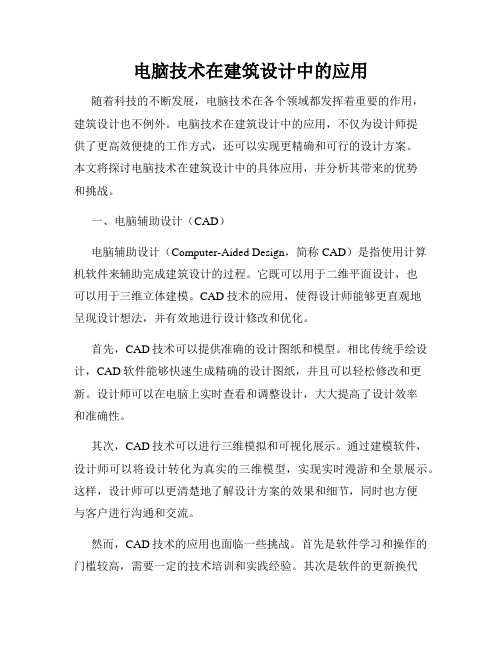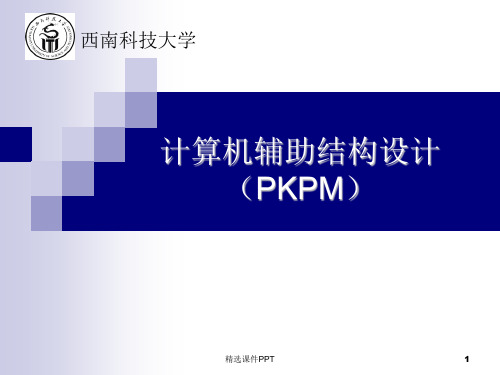第一节-计算机辅助建筑设计概述_建筑设计_经典资料
第1章 计算机辅助设计概述

教学要求目标
了解计算机辅助设计的概念、发展 掌握计算机辅助设计的工作流程 了解AutoCAD的发展及功能 了解AutoCAD的发展及功能 熟悉AutoCAD 2004操作界面 熟悉AutoCAD 2004操作界面 掌握启动和退出的方法
1
1.1 计算机辅助设计概述
AutoCAD是美国Autodesk公司开发的一个交互式绘图软件,是 用于二维及三维设计、绘图的系统工具,用户可以使用它来创建、 浏览、管理、打印、输出、共享及准确复用富含信息的设计图形。 AutoCAD AutoCAD已经成为一个功能强大、性能稳定、市场占有率位居 世界第一的CAD系统,在城市规划、建筑、测绘、机械、电子、造 船、汽车等许多行业得到了广泛的应用。统计资料表明,目前世界 上有75%的设计部门、500多万的用户应用此软件,大约有50万套 AutoCAD软件安装在各企业中运行。1998年法国世界杯足球场、波 士顿查尔斯河大桥、马来西亚 Petronas 双塔等都是它的杰作。
1.1.1 计算机辅助设计的概念 计算机辅助设计(Computer Aided Design,CAD)是利 用计算机强有力的计算功能和高效率的图形处理能力, 辅助知识劳动者进行工程和产品的设计与分析,以达到 理想的目的或取得创新成果的一种技术。它是综合了计 算机科学与工程设计方法的最新发展而形成的一门新兴 学科。计算机辅助设计技术的水平成了衡量一个国家工 业技术水平的重要标志。
3
1.1.2 CAD制图方法 交互法:直接利用绘图软件的各种功能,利用人机交互 方式将图形一笔一笔画出来。缺点是速度慢,绘图工作 量大,应用熟练后,比原始绘图要快2-3倍以上。 尺寸驱动法:
4
1.1.2 CAD的优点
计算机与信息技术在建筑与设计领域的应用与创新

计算机与信息技术在建筑与设计领域的应用与创新随着科技的飞速发展,计算机与信息技术已经成为各行各业不可或缺的一部分,其中也包括建筑与设计领域。
计算机与信息技术的应用与创新,为建筑与设计行业带来了许多重大的变革和进步。
本文将探讨计算机与信息技术在建筑与设计领域的应用和创新,并分析其对行业发展的影响和前景。
一、计算机辅助设计(CAD)计算机辅助设计(Computer-Aided Design,简称CAD)是建筑与设计领域最为常见和重要的应用之一。
传统的手工绘图方式已经逐渐被计算机绘图工具所取代。
CAD软件可以使设计师更加高效地进行图纸设计、布局规划和建模等工作,极大地提高了设计效率。
此外,CAD 还能够实现三维建模,使设计师可以更加直观地了解建筑物的外观和内部结构,减少设计错误和重新修正的次数。
二、虚拟现实技术(VR)虚拟现实技术(Virtual Reality,简称VR)是一种以计算机技术为基础的模拟现实环境的技术。
在建筑与设计领域,VR技术可以为设计师和用户提供沉浸式的体验,使其像身临其境一样感受到建筑物和室内空间的真实感。
设计师可以通过VR技术来实时预览、修改和优化设计方案,有效地减少了设计上的盲点和不确定性。
同时,用户也可以通过VR技术提前感受到建筑物的外观和体验空间的氛围,帮助决策者做出更加明智的选择。
三、建筑信息模型(BIM)建筑信息模型(Building Information Modeling,简称BIM)是一种集成多个方面信息的数字化表示方法,包括建筑的几何形状、结构、材料、设备等。
BIM技术不仅在设计阶段发挥着重要作用,还延伸到施工和运营阶段。
通过BIM技术,建筑师、结构工程师、机电工程师等不同专业的设计人员可以在同一个平台上进行合作和协同工作,提高了信息的共享和沟通效率。
此外,BIM技术还可以进行施工过程的模拟和优化,减少问题和风险,提高施工质量和效率。
四、数字化工艺与创新除了CAD、VR和BIM等已经成熟的应用外,计算机与信息技术还在建筑与设计领域带来了更多的创新。
计算机辅助设计

第1章计算机辅助设计概述1.1 计算机辅助设计的概念计算机辅助设计(Computer Aided Design,CAD),它是计算机科学技术发展和应用中的一门重要技术。
所谓CAD技术,就是利用计算机快速的数值计算和强大的图文处理功能来辅助工程师、设计师、建筑师等工程技术人员进行产品设计、工程绘图和数据管理的一门计算机应用技术,如制作模型、计算、绘图等。
计算机辅助设计对提高设计质量,加快设计速度,节省人力与时间,提高设计工作的自动化程度具有十分重要的意义。
现在,它已成为工厂、企业和科研部门提高技术创新能力,加快产品开发速度,促进自身快速发展的一项必不可少的关键技术。
与计算机辅助设计(CAD)相关的概念有:CAE(Computer Aided Engineering ):计算机辅助分析。
就是把CAD设计或组织好的模型,用计算机辅助分析软件对原设计进行仿真设计成品分析,通过反馈的数据,对原CAD设计或模型进行反复修正,以达到最佳效果。
CAM(Computer Aided Manufacture ):计算机辅助制造。
就是把计算机应用到生产制造过程中,以代替人进行生产设备与操作的控制,如计算机数控机床、加工中心等都是计算机辅助制造的例子。
CAM不仅能提高产品加工精度、产品质量,还能逐步实现生产自动化,对降低人力成本、缩短生产周期有很大的作用。
把CAD、CAE、CAM结合起来,使得一项产品由概念、设计、生产到成品形成,节省了相当多的时间和投资成本,而且保证了产品质量(如图1-1所示)。
是图1-1 计算机辅助设计过程计算机辅助设计(CAD)技术是集计算、设计绘图、工程信息管理、网络通讯等计算机及其他领域知识于一体的高新技术,是先进制造技术的重要组成部分。
其显著特点是:提高设计的自动化AutoCAD 2007应用基础教程程序和质量,缩短产品开发周期,降低生产成本费用,促进科技成果转化,提高劳动生产效率,提高技术创新能力。
《建筑计算机辅助设计课件》

建筑计算机辅助设计的优势和不足
优势:提高设计效率、减少错误、可视化展示、全周期管理。 不足:技术门槛较高、依赖于硬件和软件、可能导致创意受限。
建筑计算机辅助设计在建筑项 目中的应用
建筑计算机辅助设计在建筑项目中扮演重要角色,包括项目规划、设计方案、 施工图、工程管理等各个阶段。
建筑
拟环境中可视化和交互式地进行设计。
建筑信息模型技术的兴起,实现了设计、 施工和运营阶段的全周期管理。
建筑计算机辅助设计的应用领域
建筑项目
用于建筑设计和工程管理
景观设计
用于公园、花园和城市规划
室内设计
用于室内空间规划和装饰设计
结构设计
用于建筑结构分析和优化
建筑计算机辅助设计的工具和软件
建筑计算机辅助设计使用各种工具和软件来实现不同的设计任务,包括AutoCAD、Revit、SketchUp等。
建筑计算机辅助设计课件
欢迎来到《建筑计算机辅助设计课件》! 在这个课件中,我们将深入探讨建筑 计算机辅助设计的原理、应用及其对建筑行业的影响。
什么是建筑计算机辅助设计
建筑计算机辅助设计是指利用计算机技术来辅助进行建筑设计、分析和制图 的过程。它可以帮助设计师更高效地实现设计目标。
为什么需要建筑计算机辅助设 计
建筑计算机辅助设计能够提高设计效率、减少错误、提供更好的可视化效果, 并支持设计决策的制定。它是现代建筑设计的必备工具。
建筑计算机辅助设计的发展历程
1
手绘时代
建筑师使用纸和铅笔进行设计和绘图。
2D CAD
2
引入计算机绘图技术,实现了更快速、
1概述_计算机辅助设计

1.4 计算机辅助设计的应用
CAD的基本技术 4. 科学计算 模拟真实世界的数学、力学方法。例如有 限元、边界元等计算方法等。
1.4 计算机辅助设计的应用
CAD的基本技术 5. 优化设计 选定在设计时力图改善的一个或几个量作 为目标函数,在一定约束条件下,以数学方 法和电子计算机为工具,不断调整设计参量, 最后使目标函数获得最佳的设计。
计算机辅助设计包括的内容很多,如概念设计、 优化设计、有限元分析、计算机仿真、计算机绘 图等。
1.1 什么是计算机辅助设计
设计的重要性
“设计工作是新产品研制的第一道工序,设计 工作的质量和水平,直接关系到产品质量、性能、 研制周期和技术经济效益”——书本P1 设计的广泛性
除了花草树木这些自然景物,从茶杯到桌子、 建筑、公路、桥梁、火车……所有跟普通人生活 息息相关的物品和工程设施,都需要设计。
1.5 CAD系统的组成与配置
1.5.3.2 常用CAD软件介绍 1. 绘图软件
AutoCAD-欧特克公司 特点:专业制图,三维建模,渲染
1.5 CAD系统的组成与配置
1.5.3.2 常用CAD软件介绍 2. 造型软件
UG-美国麦道 Pro/Engineer-美国参数技术公司 CATIA-法国达索飞机公司 特点:三维,CAD/CAM,参数化设计
16
1.3 CAD的特点
工作内容
• 设计数据库 • 图形数据库 • 应用程序库
17
1.3 CAD的特点
在数据库的基础上开展CAD工作 五个方面:
• • • • • 建立模型; 设计计算; 图形显示; 仿真; 出图样、文档等。
18
1.3 CAD的特点
1)提高设计质量
综合性的技术知识;人机交互使产品设计更加合理; 优化设计;数据的一致性。
计算机辅助设施设计

殷复鹏
山东建筑大学管理学院 2011年3月
第7章 计算机辅助设施设计(CAFD)
• 第一节 概述 • 第二节 计算机辅助设施布置 • 第三节 计算机辅助设施布置的绩效分析 与评价 • 第四节 计算机辅助设施设计的未来展望
第一节 概述
一 、计算机辅助设施设计的含义及发展 二 、计算机辅助设施设计的应用
三、FACTORY-CAD在设施设计中的应用
2.FACTORYCAD系统的图形功能 ●人机对话自动生成图形 ●对图形进行各种变化 ●对图形的显示、观察功能 ●计算机报价系统
●其它功能如动画制作功能
四、新建生产系统的布置程序(FACTORYPLAN)
新建生产(服务)系统有数十种以上程 序,但最有代表性的是 FACTORYPLAN , 它是布置设计和分析的一项工具。该程序实 际上是将美国工厂设计专家 R.缪瑟创立的系 统布置设计SLP搬到计算机上来做。
一 、系统布置计算法——CORELAP程序 • 计算位置分数(Placing rating,PR):
PR wik
k
• 其中k表示已经布置的部门。
一 、系统布置计算法——CORELAP程序
• 实例分析。 • 已知相互关系如图所示。 • 各单元的面积如表所示。
1 2 3 4
部门号 1 2 3 4 5 6 7 面积 单元数
二 、计算机设施相对定位法(CRAFT)
• Computerized Relative Allocation of Facilities Technique
• 1964 , Buffa and Armour
• 在某种意义上,改进现有系统布置的算法与程序比构造算 法与程序具有更广泛的应用价值。 • 从已知的初始布置方案出发,通过设备间进行有规律的交 换,寻找最佳结果。 • 该方法是一个以各作业单位之间物料搬运费用逐步减少的 优化原则改进布置方案的算法与程序。 • 不同的初始方案得到不同的解。
计算机辅助建筑设计与仿真

计算机辅助建筑设计与仿真计算机辅助建筑设计与仿真技术是现代建筑设计领域中的重要工具。
随着科技的发展和计算机技术的日新月异,越来越多的建筑设计师开始利用计算机软件来辅助他们进行设计和仿真,以获得更准确、更高效的设计结果。
本文将探讨计算机辅助建筑设计与仿真的意义、应用领域和技术进展。
一、计算机辅助建筑设计与仿真的意义计算机辅助建筑设计与仿真技术的出现和普及,对于建筑设计行业带来了革命性的变化。
它将建筑设计师从繁琐的手绘和纸质设计中解放出来,提高了设计效率和准确性。
通过计算机软件,设计者可以直观地展示和调整建筑模型、进行各种参数的优化,从而使设计结果更加贴合需求和视觉效果。
二、计算机辅助建筑设计与仿真的应用领域计算机辅助建筑设计与仿真技术广泛应用于建筑设计的各个环节,包括建筑概念设计、结构设计、构造设计、室内设计等。
其中,建筑概念设计是计算机辅助设计的重点领域之一。
通过使用建筑设计软件,设计师可以迅速构建出各种形态的建筑模型,实现设计概念的可视化展示。
在结构设计方面,计算机辅助设计可以帮助工程师进行力学分析和结构优化,减少结构的材料消耗和成本。
仿真技术也被广泛运用于建筑施工过程的模拟和优化,可以帮助规划施工进程、确保施工质量和安全。
室内设计方面,计算机辅助设计和仿真技术可以帮助设计师呈现出更直观的室内空间效果,对光照、色彩和材质等进行模拟和调整,提供更真实的设计预览。
三、计算机辅助建筑设计与仿真的技术进展随着计算机技术的快速发展,计算机辅助建筑设计与仿真技术也取得了很大的进展。
目前,三维建模、虚拟现实和增强现实等技术已广泛应用于建筑设计领域。
三维建模是计算机辅助建筑设计的核心技术之一。
通过三维建模软件,设计师可以将建筑模型建立为三维实体,实现对建筑形态、材质和光影的模拟和调整。
虚拟现实技术使得建筑师和用户可以在计算机模拟的虚拟环境中进行交互和体验。
虚拟现实技术可以模拟真实的建筑空间,提供沉浸式的视觉和感官体验,帮助用户更好地理解和评价设计方案。
《建筑CAD中文》助教课件

建筑CAD中文助教课件1.建筑CAD(计算机辅助设计)是指利用计算机技术来辅助进行建筑设计的过程。
本助教课件旨在帮助学员快速掌握建筑CAD中文的基本概念、工具和技巧。
2. 建筑CAD中文的基本概念2.1 CAD的定义CAD(Computer-Aided Design)是指利用计算机来辅助进行设计和绘图的过程。
在建筑领域,CAD通常涉及建筑的平面布局、立面设计、图纸绘制等方面。
2.2 建筑CAD中文的特点建筑CAD中文主要关注于中文环境下的建筑设计和绘图。
相比于其他语言环境下的CAD工具,建筑CAD中文更加贴近中国建筑行业的实际需求,具有更多针对性的功能和工具。
3. 建筑CAD中文的工具和技巧3.1 CAD软件的选择在建筑CAD中文的学习和实践过程中,选择合适的CAD软件是非常重要的。
常用的建筑CAD中文软件包括AutoCAD、SketchUp、Revit等。
本课件将以AutoCAD为例进行讲解。
3.2 基本操作和快捷键在使用建筑CAD中文软件进行设计和绘图时,掌握基本的操作和常用的快捷键是提高工作效率的关键。
例如,常用的绘图工具包括直线、多边形、圆形等;常用的修改工具包括移动、旋转、缩放、镜像等。
学员需要熟悉这些工具和技巧,并通过反复练习加深记忆。
3.3 图层管理在建筑CAD中文设计中,图层管理是非常重要的一部分。
通过合理的图层管理,可以使设计和绘图更加高效、清晰。
学员需要学会创建、修改和管理图层,并理解不同图层的作用和使用方法。
3.4 三维建模和渲染除了平面图的设计和绘制,建筑CAD中文还可以进行三维建模和渲染。
通过三维建模,可以更加直观地展示建筑设计的效果。
学员需要学会使用建筑CAD中文软件进行三维建模,并掌握常用的渲染技巧。
4. 实践案例分析本部分将通过实践案例分析,展示建筑CAD中文在实际项目中的应用。
学员将学习到如何运用建筑CAD中文进行平面设计、立面设计、结构设计等方面的工作,并了解不同项目的特点和要求。
计算机辅助建筑设计(CAD和SketchUp)

重生成Regen
定数等分 DIVIDE 定距等分 MEASURE
在线上按等分距离放置点 在线上按给定长度放置点
对于圆,从圆心出发的零度角与圆的交点开始长度计算 定距等分:从线的终点处开始长度计算
刚刚生成的定数等分点或定居等分点都会被放置在前一次的选择集内
点、线、面的操作,着重在线。 由一系列的线条组成整个图形。 线有各种属性:图层、颜色、线型、线宽 等
线和面的操作,着重在面。 由一系列的面围合成整个三维模型。 面有各种属性:颜色、材质、图层等
AutoCAD 通用性工程绘图软件
输出:SketchUp
3dsMAX
WMF
TIF
SketchUp 方便快捷的三维建模软件输出:AutoCAD
多线 MLINE
ACAD图形要素
练习: 网球场
直线段Line
复制Copy 移动Move 偏移Offset 延伸Extend 修剪Trim 圆角Fillet
线型Linetype
计算机辅助设计和应用
AutoCAD中的图形要素
ACAD图形要素
点型要素 直线型要素 圆弧型要素 多边形要素 复合型要素 区域型要素 其它要素
ACAD图形要素
圆弧型要素: 圆 CIRCLE
圆心,半径 Center, Radius 圆心,直径 Center, Diameter 直径的两个端点 2 Points 圆周上的三点 3 Points 与两个对象相切并指定半径 Tan, Tan, Radius 与三个对象相切 Tan, Tan, Tan
计算机辅助设计和应用
Computer Aided Design
观察模型的方式 操作模型的方式 生成设计的方式
建筑知识:计算机辅助建筑设计的实践应用

建筑知识:计算机辅助建筑设计的实践应用计算机科学和技术的飞速发展,不仅为工业、商业和科学领域带来了巨大的进步,同时也为建筑设计领域带来了前所未有的机会和挑战。
计算机辅助设计(CAD)以其高效、精确、灵活等优点,逐渐成为科技时代的当代建筑师最重要的工具之一。
本文将探讨计算机辅助建筑设计的基础知识和实践应用。
计算机辅助建筑设计概述计算机辅助建筑设计就是利用计算机的强大计算和处理能力,为建筑师提供一个高效、准确和灵活的设计平台。
计算机辅助建筑设计可以有效地实现建筑设计的自动化和智能化,使设计师可以更加专注于设计理念的创新和实现。
计算机辅助建筑设计的优势计算机辅助设计相对于传统的手工设计,具有明显的优势和潜力。
首先,计算机辅助设计可以通过增强建筑师的视觉表达能力,提高设计的审美和艺术水平。
其次,通过实现自动化的计算和模拟,可以在规划阶段获得更加全面的设计信息和分析结果,尽可能预测并避免建筑设计的潜在问题。
此外,它有效地优化了协作工作流程,促进了不同团队之间的准时和高效的合作交流。
CAD软件在实践中的应用在现代建筑设计中,CAD软件已经成为了主要的设计工具之一。
例如AutoCAD、SketchUp、Revit、Rhino等,都是广泛应用于各个阶段的建筑设计中。
这些软件可以在方案设计、制图、3D模型等各个方面提供便利。
以下为几个实用的应用案例:方案设计:在初始设计阶段,CAD软件通常用于直接描绘想法,包括建筑布局、外观和表现风格,这使设计师可以更好地了解想法并进行更深入的分析。
这些设计可以轻松传输到其他软件中,如渲染软件或3D建模软件,以创建更详细的模型或渲染更加逼真的图像。
图纸制作:在后期设计中,CAD软件可以用于绘制尺寸精度高的建筑图纸和特殊细节。
在此阶段计算机可以帮助自动生成一些标注和细节,并提供快速修改或更新的能力。
3D模型的创建:Revit等CAD软件为金字塔建筑、独特和复杂的结构、混凝土构造等特殊项目的建模提供了方便。
电脑技术在建筑设计中的应用

电脑技术在建筑设计中的应用随着科技的不断发展,电脑技术在各个领域都发挥着重要的作用,建筑设计也不例外。
电脑技术在建筑设计中的应用,不仅为设计师提供了更高效便捷的工作方式,还可以实现更精确和可行的设计方案。
本文将探讨电脑技术在建筑设计中的具体应用,并分析其带来的优势和挑战。
一、电脑辅助设计(CAD)电脑辅助设计(Computer-Aided Design,简称CAD)是指使用计算机软件来辅助完成建筑设计的过程。
它既可以用于二维平面设计,也可以用于三维立体建模。
CAD技术的应用,使得设计师能够更直观地呈现设计想法,并有效地进行设计修改和优化。
首先,CAD技术可以提供准确的设计图纸和模型。
相比传统手绘设计,CAD软件能够快速生成精确的设计图纸,并且可以轻松修改和更新。
设计师可以在电脑上实时查看和调整设计,大大提高了设计效率和准确性。
其次,CAD技术可以进行三维模拟和可视化展示。
通过建模软件,设计师可以将设计转化为真实的三维模型,实现实时漫游和全景展示。
这样,设计师可以更清楚地了解设计方案的效果和细节,同时也方便与客户进行沟通和交流。
然而,CAD技术的应用也面临一些挑战。
首先是软件学习和操作的门槛较高,需要一定的技术培训和实践经验。
其次是软件的更新换代较快,设计师需要不断学习和适应新版本的功能和操作方式。
此外,CAD软件依赖于电脑硬件的配置和性能,较高的硬件要求可能增加了成本和门槛。
二、建筑信息模型(BIM)建筑信息模型(Building Information Modeling,简称BIM)是指通过电脑技术将建筑设计的各个方面进行数字化建模,并将其整合在一个统一的信息平台中。
BIM技术的应用,旨在实现建筑设计和建造全过程的信息共享和协同工作。
首先,BIM技术可以实现多学科间的集成和协作。
传统建筑设计存在设计方案信息孤立的问题,导致建筑设计和建造过程中的沟通和配合不畅。
而BIM模型能够将建筑设计、结构设计、设备设计等各个学科整合在一个模型中,并通过共享平台进行即时协同工作,提高信息的一致性和可靠性。
计算机辅助结构设计(PKPM)精ppt课件

通过以上学习和操作,使学生们循序渐进地熟悉结构平 面计算机辅助设计的过程,能够根据建筑方案,用PMCAD 系列软件进行建筑结构辅助设计,完成结构设计计算,绘制 出楼板、框架梁柱结构施工图 。
本课程教材选用《建筑结构CAD—PKPM软件应用》 , 中国建筑工业出版社04年版,王小红、罗建阳编著。
注:本课件应配合西南科技大学网络学院相应的录像课程使 用。录像课程中所用的两个工程实例资料见本课件第八 章后面实例1及实例2。
由于建立了整栋建筑的数据结构, PMCAD 成为 PKPM 系列结构设计软件的核心,它为各功能设计提供数据接口。
计算机结构辅助设计
第一章 PMCAD 的基本功能与应用范围
第一节、PMCAD 的基本功能 一、人机交互建立全楼结构模型
人机交互方式引导用户在屏幕上逐层布置柱、梁、墙、 洞口、楼板等结构构件,快速搭起全楼的结构构架,输入过 程伴有中文菜单及提示,并便于用户反复修改。
第一章 PMCAD 的基本功能与应用范围
3、引导用户人机交互地输入或修改各房间楼面荷载、次 梁荷载、主梁荷载、墙间荷载、节点荷载及柱间荷载,并方 便用户提供复制、拷贝、反复修改等功能。
4、各类荷载均可以平面图形方式标注输出,也可以数据 文件方式输入,可分类详细输出各类荷载,也可综合迭加输 出各类荷载。
第一章 PMCAD 的基本功能与应用范围
3、为空间有限元壳元计算程序 SATWE 提供数据, SATWE 用壳元模型精确计算剪力墙,程序对墙自动划分壳单 元并写出 SATWE 数据文件(这部分功能放在 SATWE 中)。
4、为三维空间杆系薄壁柱程序 TAT 提供计算数据,程序 把所有梁柱转成三维空间杆系,把剪力墙墙肢转成薄壁柱计算 模型。(这部分功能放在 TAT 模块中)。 四、为上部结构各绘图 CAD 模块提供结构构件的精确尺寸, 如梁柱总图的截面、跨度、挑梁、次梁、轴线号、偏心等,剪 力墙的平面与立面模板尺寸,楼梯间布置等等。 五、为基础设计 CAD 模块提供底层结构布置与轴线网格布置, 还提供上部结构传下的恒活荷载。
建筑电气计算机辅助设计

建筑电气计算机辅助设计引言建筑电气计算机辅助设计是利用计算机技术和相关软件工具来辅助进行建筑电气设计的过程。
随着计算机技术不断发展和普及,电气工程领域也逐渐引入计算机辅助设计,以提高设计效率、减少错误和优化设计方案。
在建筑电气设计中,计算机辅助设计工具可以帮助工程师进行电气负载计算、照明设计、插座位置规划、电气系统模拟和优化等工作。
本文将介绍建筑电气计算机辅助设计的基本原理、常用软件工具和应用案例。
基本原理建筑电气计算机辅助设计基于计算机辅助设计(CAD)技术,通过建立建筑模型和电气系统模型,并在计算机上进行模拟和分析,以帮助工程师进行电气设计。
具体包括以下几个方面:1.建筑模型生成:利用CAD软件工具绘制建筑平面图、立面图和剖面图,建立三维建筑模型。
建筑模型需要包括建筑的空间结构、房间布局、门窗位置等信息。
2.电气系统模型生成:根据建筑模型,在CAD软件中建立电气系统模型。
电气系统模型需要包括电气线路、插座、开关、照明设备等信息。
3.负载计算和分析:根据建筑模型和电气系统模型,计算电气负载,包括照明负载、插座负载、设备负载等。
通过计算机辅助设计工具,可以自动对不同负载进行计算和分析,以确定正确的电气设备容量和规格。
4.照明设计:利用计算机辅助设计工具进行照明设计,包括灯具布置、亮度计算、照明效果模拟等。
通过模拟和分析不同照明方案,可以选择最佳方案,提高照明效果和节能性能。
5.插座位置规划:根据建筑模型和使用需求,通过计算机辅助设计工具,在建筑平面图中进行插座位置规划。
通过模拟和分析不同插座布置方案,可以确定最优的插座位置,以满足使用需求。
6.电气系统模拟和优化:利用计算机辅助设计工具进行电气系统模拟和优化,以提高系统的可靠性、节能性和安全性。
通过模拟和分析不同电气系统配置和参数,可以优化设计方案,减少能源消耗和故障风险。
常用软件工具在建筑电气计算机辅助设计中,有许多常用的软件工具可以提供设计支持和计算分析。
第一章计算机辅助

1.1 CAD概述
1.1.1 CAD的概念、特点及其发展概况
计算机辅助设计,即英文Computer Aided Design,简称CAD。 它是指人们在计算机软、硬件的辅助下对产品设计者对产品进 行设计、绘图、分析计算、修改和编写技术文件以及显示、输出的一 种设计方法。 CAD系统:一般把应用于CAD作业的计算机(中、小型或微型 计算机等)、软件(计算机的操作系统、图形支撑软件和专用应用 软件等)及外围设备(打印机和绘图仪等),总称为CAD系统。
图1-3
滚筒式绘图机
隔行扫描的行扫描频率为逐行扫描时的一半 每一帧图像均是由电子束顺序地一行接 着一行连续扫描而成,这种扫描方式称为 逐行扫描。要得到稳定的逐行扫描图像, 每帧图像必须扫描整数行。举例来说,一 帧图像是连续扫描625行组成的,每秒钟共 扫描50帧图像,即帧扫描频率为50帧/秒, 或写成50Hz(赫芝),行扫描频率为 31.25kHz。
计算机主机是控制和指挥整个系统运行并执行实际运 算、逻辑分析的装置。
2. 输入设备
计算机及外存储器是通过输入、输出设备与外界来沟通信息的。 所谓输入,就是把外界的信息变成计算机能够识别的电子脉冲, 即由外围设备将数据送到计算机内存中。
输入设备的主要作用是将字符、平面或空间中点的坐标输入计算机, 其基本功能是“定位”和“拾取”。 “定位”是确定和控制光标在屏幕图形上的位置,“拾取”是选区屏幕图 形上的某一部分内容。
► 三维造型
采用实体造型设计零部件结构,经消隐及着色等处理后显示物体 的真实性状,还可做装配及运动仿真,以便观察有无干涉等。
►工程分析
常见的分析有:有限元分析、优化设计、可靠性设计、运动学及 动力学分析等。此外,针对某个具体设计对象还有它们自己的工程分 析问题,如注塑模设计中要进行塑流分析 、冷却分析 、变形分析等 。
建筑计算机辅助设计

建筑学术语
目录
01 介绍
03 建筑设计表现
02 科学技术进步 04 总结
随着科学技术的进步和计算机技术的不断完善,计算机辅助设计对于建筑设计,无论是在方法上还是在观念 上都将起到至关重要的作用,以至最终将改变和影响今后在建筑设计方法和建筑观念。
介绍
在CAD计算机辅助设计异军突起与建筑设计领域之后,计算机已经成为建筑设计人员工作中一个重要的工具。 计算机的使用已经改变了许多的工作方法,正如众所周知,正如众所周知,计算机绘制的线条图和计算机绘制的 建筑表现图已经发展到了相当成熟的阶段,我们作为现代的建筑设计师,不能回避工具的更新对建筑设计带来的 影响,同时也不能将新工具在建筑设计中的运用按传统的方式直接套用到建筑计过程中来。
总结
目前,在我们大部分设计单位,电脑在建筑设计中的作用往往局限于在施工图的绘制和单纯的电脑效果图表 现上。存在着设计与表现脱节的现象,电脑参与方案设计本身的潜能还没有充分地发掘。今后,我们应该充分发 挥计算机能使建筑设计的各种变化更具有潜力的特点,改变以往对建筑设计程式化的理解方式,在建筑领域更广 泛的运用电脑技术来进行建筑辅助设计。我们有理由相信,随着计算机技术的进一步发展和人类识别水平的提高, 计算机辅助设计的作用将会越来越明显,设计与表现一体化的进程将大大加快,并最终会影响到建筑与设计方式 的变革
计算机可视化技术越来越成为建筑师不可缺少的工具。人们可以把天空、树木、人物以及准备建设的区域附 近的其他景点通过数码相机拍摄下来,并将这些图像输入到电脑里,当我们在电脑里将新设计的建筑三维模型基 本完成之后,便将他们一同组织到计算机模型中。这样不仅使我们设计的建筑业与周边环境的关系更加真实可信, 同时还可以利用计算机便于修改的功能,在显示图像的时候随时调整三维建筑模型,使建筑物与周围环境的关系 更加和谐统一。电脑这一新的技术手段,可以让我们自始至终在直观、真实的三维环境里进行建筑设计和创作, 从而可以较大程度地提高建筑设计质量。
计算机辅助建筑设

整理ppt
24
点击构件 —— 修改栏 —— 修改属性
整理ppt
25
点击构件 —— 属性栏 —— 修改属性
整理ppt
26
项目浏览器
整理ppt
பைடு நூலகம்
27
项目浏览器
整理ppt
28
视图选择 双击
整理ppt
29
视图选择 在画图区双击 标示符
整理ppt
30
选择
整理ppt
31
单击选择 多选 ctrl + 点击 多选中减选 shift
整理ppt
69
此课件下载可自行编辑修改,供参考! 感谢您的支持,我们努力做得更好!
整理ppt
32
查看方式
整理ppt
33
放大器
整理ppt
34
滚轮放大
整理ppt
35
适应窗口
Zoom fit
ZF
整理ppt
36
窗口缩放工具
整理ppt
37
3D 查看
整理ppt
38
Shift + 鼠标中键 —— 旋转控制
整理ppt
39
调板栏的使用
整理ppt
40
点击构件 —— 属性栏 —— 修改属性
快捷启动栏
整理ppt
15
自定义快速访问工具栏
整理ppt
16
工具栏
整理ppt
17
常用
整理ppt
18
修改栏
整理ppt
19
物件修改
整理ppt
20
修改栏 —— 针对物体项目而存
整理ppt
21
修改栏 —— 通用修改
整理ppt
建筑行业计算机设计技术

CATALOGUE 目录•建筑行业计算机设计技术概述•建筑行业计算机设计技术的基本原理•建筑行业计算机设计技术的实践应用•建筑行业计算机设计技术的未来趋势•建筑行业计算机设计技术案例分析建筑行业计算机设计技术的发展历程起源与初期发展01快速发展与普及02智能化与数字化03建筑行业计算机设计技术的应用范围方案设计施工图绘制效果图渲染三维建模与可视化建筑行业计算机设计技术的优势与挑战优势提高设计效率:计算机设计软件能够快速进行图形绘制、修改和渲染,大大提高设计效率。
提高设计质量:利用CAD软件的精确绘图功能,可以减少人为错误,提高设计质量。
建筑行业计算机设计技术的优势与挑战建筑行业计算机设计技术的优势与挑战对传统方法的冲击:计算机设计技术的普及对传统的手工绘图和模型制作方法造成一定冲击,需要平衡新旧技术的关系。
图形交互通过图形界面,用户可以与计算机生成的图形进行交互,如放大、缩小、旋转等操作。
图形学原理计算机图形学计算机图形学是研究图形生成、处理及交互的学科,在建筑行业中,计算机图形学被广泛应用于建筑模型的设计、渲染及可视化。
图形生成通过数学算法和程序,将数据转化为具有三维特征的图像,包括线条、色彩、纹理等元素。
图形处理对生成的图像进行各种操作,如缩放、旋转、变形等,以满足设计需求。
计算机视觉原理计算机视觉是利用图像处理技术和机器学习算法,让计算机能够“看懂”并分析图像数据。
计算机视觉图像采集图像处理图像分析通过相机、扫描仪等设备获取图像数据。
对获取的图像数据进行处理,如去噪、增强、分割等。
通过机器学习算法,对处理后的图像进行分析,提取有用的信息。
数据库管理数据模型数据查询数据维护数据库管理原理虚拟现实技术原理虚拟现实虚拟现实技术通过模拟真实环境,使用户能够沉浸其中并与之进行交互。
三维建模通过三维建模技术,创建与真实环境相似的虚拟环境。
环境渲染对虚拟环境进行渲染,以实现逼真的视觉效果。
交互体验通过虚拟现实设备,用户可以在虚拟环境中进行操作和体验。
- 1、下载文档前请自行甄别文档内容的完整性,平台不提供额外的编辑、内容补充、找答案等附加服务。
- 2、"仅部分预览"的文档,不可在线预览部分如存在完整性等问题,可反馈申请退款(可完整预览的文档不适用该条件!)。
- 3、如文档侵犯您的权益,请联系客服反馈,我们会尽快为您处理(人工客服工作时间:9:00-18:30)。
putermuseum.li/Testpage/Bendix-G15-1950s.htm
60年代
60年代的CAAD系统是历史上第一代的CAAD系统,应用的 计算机为大型机,体积庞大,图形显示以刷新式显示器为基 础, CAD装置的价格昂贵绘图和数据库管理的软件比较原始, 功能有限。在当时,CAAD中的“D”,与其说是Design,还不 如说是Drawing或Drafting。因此第一代的CAAD系统不太合 建筑师的口味,而且整个CAD装置的价格昂贵。许多建筑师 仍然不知道计算机能够帮他们干些什么,有的甚至对CAAD怀 有敌意。整个建筑业界普遍仍然使用“趴图板”方式搞建筑 设计。但不管怎样,计算机技术已经引起人们的注意。事实 上到了60 年代末,在西方已经有建筑师事务所开始应用 CAAD系统。
Ivan Sutherland at the console of the TX-2 Sketchpad Project, MIT, 1963
Dr. Ivan Sutherland in the classroom,California Institute of Technology, 1976
但是,人们还是认为计算机辅助建筑设计技术研究的起点始于1958 年, 这一年,美国的埃勒贝建筑师联合事务所(Ellerbe Associates)装置了 一台 Bendix G15的电子计算机,进行了将电子计算机运用于建筑设计的 首次尝试。
计算机辅助建筑设计
第一讲:简介
课程主要内容:
• 计算机辅助设计课程简介 • 计算机图形学的相关知识
图形绘制、图形变换、曲线/曲面、图形渲染……
• Rhino软件及Grasshopper参数化设计 • BIM及软件应用(Revit)
计算机辅助设计简介
CAD(Computer-Aided Design)
Job Stam,The Art of Fluid An63年,美国麻省理工学院的博士研究生 Ivan Sutherland 发表了 他的博士学位论文《Sketchpad:一个人机通讯的图形系统》,并在计算 机的图形终端上实现了用光笔绘制和修改图形,控制图形的缩放。这项 工作被公认为计算机图形学方面的开创性工作,也为以后计算机辅助设 计技术的发展奠定了理论基础。 /classes/cs6751_97_fall/projects/abowd_team/ivan/ivan.html
计算机辅助设计(CAD)的定义是:使用计算机系统来辅 助一项设计的建立、修改、分析或优化。计算机辅助设计系 统包括硬件和软件系统,用以完成不同用户的专业设计功能。
CAAD(Computer Aided Architectural Design)
20世纪60年代,最初由波音公司的研究人 员提出计算机图形学的名词时,指的是计算机 生成图像(Computer Generated image)的技术, 主要涉及将三维工件投影到二维平面的方法, 用于计算机辅助设计。到20世纪80年代以来, 越来越关注自然场景的逼真生成和显示,计算 机仿真、计算机辅助训练、计算机动画、虚拟 现实、增强现实等发展迅速。
Bendix G15 Computer (circa 1958)
The BENDIX G-15 computer was manufactured by Bendix Aviation Corporation, Computer Division, Los Angeles, California, in the mid to late 1950's. The BENDIX G-15 was about 5 x 3 x 3 feet and weighed about 950 pounds. The base system, without peripherals, cost $49,500 and was available at a monthly rental fee of $1,485. The G-15 could utilize a high-speed paper tape punch for output, punched cards, or a graph plotter. It used magnetic tape storage. It utilized paper tape or punched card input. The G-15D could perform addition or subtraction functions at about 2.5 milliseconds and multiplication or division at about 20 milliseconds. The G-15 had vacuum tubes and germanium diodes. 180 tube packs and 300 diode packs.
Ivan Sutherland is considered by many to be the creator of Computer Graphics. Starting with his Ph.D. thesis, Sketchpad, Sutherland has contributed numerous ideas to the study of Computer Graphics and Computer Interaction. Ivan introduced concepts such as 3-D computer modeling, visual simulations, computer aided design (CAD) and virtual reality.
70年代
DEC公司的PDP系列16位计算机问世,在20世纪70年代初,计算机的性能价格 比大幅度提高
